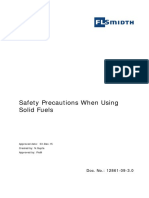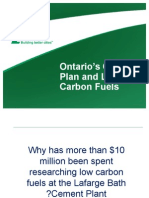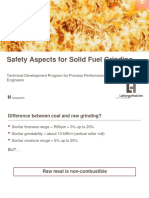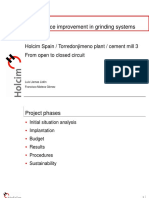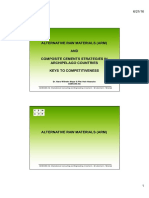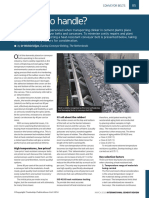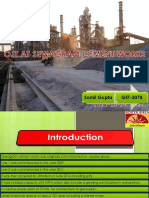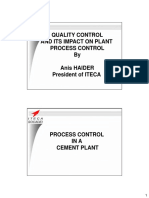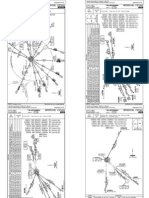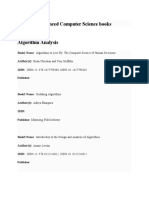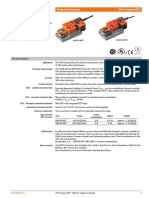Homogenizing Silos
BE READY – BUILDING FOUNDATION
October 2017
�Homogenising Process
© 2017 LafargeHolcim 2
�Homogenising Silo
General goals ...
• Material stock between raw mill and kiln
o Requirement: Cover raw mill downtime
• Even out fluctuations in raw meal coming from the mill or kiln dust
recirculation
o Capacity requirement: Multiple of fluctuation frequency
Uniformity target: sLSF < 1.2 (kiln feed, short term)
© 2017 LafargeHolcim 3
�Homogenising Principles
• Mixing • Blending
o Agitation of an inhomogeneous batch o Combining different qualities
© 2017 LafargeHolcim 4
�How can we measure the Homo Silo Efficiency?
• The blending Efficiency is the relation
between (LSF) input and output standard
deviation. Example:
• Sampling campaign of a continuous
homosilo (50 samples each) show
o STD inlet samples: 5.5
o STD outlet (kiln feed) samples: 1.3 Is 4.2 GOOD or BAD???
o Silo Blending Efficiency = (5.5 / 1.3) = 4.2
Let’s wait for
the case
o How would you judge the kiln feed study
uniformity?
© 2017 LafargeHolcim 5
� Homogenising Silos
Three basic systems
Homogenising
silo
storage
silo
Batch Homogenising Continuous Multi-pack Blending
Silos Blending Silos Silos
Fully agitated batch mixer Continuous blender Continuous blender
© 2017 LafargeHolcim 6
�Batch Homogenising Silos
• Batch type
• Two storey arrangement
o Homogenizing silo (above)
o Storage silo (below)
• Always two parallel silos
© 2017 LafargeHolcim 7
�Batch Homogenising Silos
© 2017 LafargeHolcim 8
�Batch Homogenising Silos
Silo inlet fluctuations
concentration inlet
time
Outlet fluctuations with a batch type homogenizing silo
concentration outlet
quality step
goal mean between
value batches
time of 1 batch
time
Get Ready - Homogenizing Silos © 2017 HTEC 9
�Batch Homogenising Silos
Advantages Disadvantages
• Most efficient raw meal • High energy consumption
homogenising system • Application limited to around 2000 t
• Blending potential around 10:1 chambers, thus only for production
lines up to 3000 t/d
• High investment cost for new
installations
© 2017 LafargeHolcim 10
�Continuous Blending Silos
• Spider on top for meal distribution
• Layering of material
• Inverted cone concept
o Empty cone (IBAU, Polysius)
o Centre chamber (CP)
• Combination of different layers while
extracting
• Extraction by pneumatic control valve
© 2017 LafargeHolcim 11
�Continuous Blending Silos
• Material flowing downwards in funnels much smaller than sector
dimensions
• Homogenising takes place at material surface by blending from
different layers (i.e. material that has been ground at different times)
© 2017 LafargeHolcim 12
�Continuous Blending Silos
• Silo Design (IBAU type) • Silo Operation
o Number of sectors > D [m] o Operate at high filling degrees (> 75 %)
o Cone-to-wall distance < 2 m o Activate single sectors
o Max. air pad length < 2.5 m o Sector activation sequence preventing
o Air pad width 200 mm intersection of funnels
o Aerated bottom area > 35 % o Aeration rate around 1-1.5 m3/(m2*min)
o Low aeration pressure
o Aeration sequence time 5-12 min
© 2017 LafargeHolcim 13
�Continuous Blending Silos – FLS-CF Type
• No spider required on top
• Flat bottom with 7 outlets
• Product discharge at different rates,
creating controlled layer inclination
o Strictly follow manual for operation!
© 2017 LafargeHolcim 14
�Continuous Blending Silos
15
�Continuous Blending Silos
• Difficulties dealing with peaks in compositional fluctuation
• Kiln dust addition into silo
o Starvation of a raw mill feeder
© 2017 LafargeHolcim 16
�Continuous Blending Silos
Advantages Disadvantages
• Applicable for wider capacity • Limited blending potential of up to
ranges (5’000 – 20’000 t) 5:1
• Low energy consumption o Decreasing blending effect with
increasing raw meal uniformity
• Insufficient reduction of
o Long term fluctuations
o Peak type disturbances
o Step type disturbances
© 2017 LafargeHolcim 17
�Multi-Pack Blending Silos
• Subsequent filling of silo cells
• Simultaneous reclaiming from all cells
• Separate chamber for kiln dust handling
© 2017 LafargeHolcim 18
�Multi-Pack Blending Silos
Advantages Disadvantages
• Suitable for very critical • Limited blending potential of up to
materials 3:1
o Segregation • High investment cost
o Quality control
• Fixed blending efficiency
depending on the number of
silos
© 2017 LafargeHolcim 19
�Kiln Dust Handling
�What is the problem with the dust?
• A part from the raw meal out of the mill goes to the kiln filter, mixes with
the kiln dust and is also added to the homosilo.
• When the mill is stopped only kiln dust is generated and might be still
added to the silo. But in some cases the chemical composition of the dust
is different from the raw meal.
• When this difference is big (indicated by the ‘segregation factor) ‘a special
solution has to be found to avoid kiln feed quality fluctuations in case of a
raw mill stop.
21
�Segregation Factor
•Tendency of a raw meal to cause segregation problems
•Indication of high deviation of kiln dust chemistry from raw meal chemistry
LS32m LSkiln dust
Sf LS or for existing plants: Sf
LS RawMeal LSkiln feed
Critical Not Critical Critical
Sf < 0.8 0.8 < Sf < 1.2 Sf > 1.2
22
�Kiln Dust Handling
•Compound operation: Raw meal & kiln dust to silo
•Direct operation: Kiln dust to silo
23
� What happens if the SF is out of spec?
Direct operation
Compound operation
(raw mill is stopped)
(raw mill is running)
Shorter stop Longer stop
Large layer of ‘of spec raw meal’ causes kiln operation and clinker
quality problems
24
�Kiln Feed Proportioning
25
�Kiln Feed Requirements
•Constant reclaim from kiln feed bin
•Permanent (gravimetric) rate control
•High feed rate accuracy for a wide control range
•Consistent raw meal transport to the kiln
•High operation reliability
•Fully enclosed design
•Low maintenance requirement
26
�Kiln Feed Bin
•Sizing for at least 20 minutes of
kiln operation
•Installation on load cells
•Operation at constant level (70 -
80 % filling)
•Feed rate control out of raw meal
silo by flow control gate
•Kiln feed rate measurement /
control with either
•Rotor scale OR
•Coriolis flow meter
27





